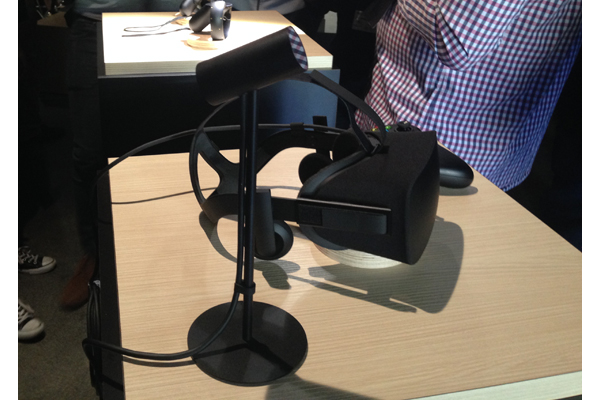Get Your Room-Scale VR On, Pre-orders For Third Oculus Sensor Available Now
Oculus revealed the price and release date for Oculus Touch during the Oculus Connect 3 developer conference in early October, and the company finally confirmed that the Rift is indeed capable of room-scale VR—with on caveat: You need a third sensor, which doesn’t come with the Touch controllers.
The Oculus Touch package includes two Touch controllers, a second sensor, and a connector for Rock Band controllers. With two sensors (the first one comes with the Rift), you can configure the setup for forward facing games by putting the two sensors on opposing sides of your desk. Or, you can place them in opposing corners for 360-degree tracking. Two sensors aren’t enough for full room-scale VR because the range of the Oculus sensors is too small. When you add a third sensor, the system can track your movement in a much larger space.
The Oculus Touch pre-orders opened recently, but you couldn’t order a third sensor for room-scale VR on October 10. As of today, you can. Oculus is charging $79 for an individual sensor. It also includes a five-meter extension cable so you can place the third sensor behind you.
Oculus Touch controllers start shipping on December 6, and the extra sensors will ship at the same time.
Get Tom's Hardware's best news and in-depth reviews, straight to your inbox.
Kevin Carbotte is a contributing writer for Tom's Hardware who primarily covers VR and AR hardware. He has been writing for us for more than four years.
-
Sakkura No, you don't necessarily need a third sensor for room-scale VR. It depends on how big of an area you want covered. If you have an enormous room you may need 4. Most people won't have a ton of room to dedicate to VR, so 2 cameras will be sufficient.Reply -
kcarbotte Reply18807674 said:No, you don't necessarily need a third sensor for room-scale VR. It depends on how big of an area you want covered. If you have an enormous room you may need 4. Most people won't have a ton of room to dedicate to VR, so 2 cameras will be sufficient.
2 cameras don't provide enough coverage for room scale.
You can do standing 360 and take a step in either direction, but you need the third camera for proper room-scale VR.
-
Specter0420 I wish OSVR had support for multiple trackers. Any coding guys in here want to help the open source community out?Reply
I have a HDK2 and it blows the CV1 and Vive away in everything but tracking. The tracking just needs software fixes, some of the IR LEDs in the sides and the ones on the back aren't even recognized and the software doesn't support multiple trackers yet... -
cryoburner So, around $900 for an Oculus Rift setup that can sort of do roomscale, only probably still not as well as a Vive? Even the Vive at around $800 seems a bit overpriced when you consider that this is all first-gen hardware that will be obsolete within a couple years. Who's going to want to use this equipment once there's HMDs with far more comfortable mounting systems, sharper screens, higher refresh rates, and eye tracking for foveated rendering to allow for much higher performance at any given resolution? Microsoft revealed just the other day that a number of Windows-compatible VR headsets will be shipping from various companies within the next year, some with prices as low as $300, so depending on how those turn out, these early devices could potentially be outdated or outpriced sooner than many might think. The motion controllers are also first-gen, and could easily be superseded with incompatible tech within a few years.Reply
I guess I just recall the early days of the Oculus Rift, when the consumer version was said to be planned for somewhere in the $300-$400 price range just like the devkits, and I expected VR controllers might be around $100 a pair. When they sold out to Facebook, a lot of the justification they gave was that it would allow them to sell the headsets for the lowest price possible, and avoid any shortages at launch, neither of which turned out to be true. Not only did the headsets take way longer to release than most were expecting, but they also cost significantly more, and stock is still limited. The Vive at least always claimed that it would offer a premium VR experience at a premium price. The Rift was originally intended to be VR for everyone, but I guess Facebook had to find some way to make back the $2 billion that they overpaid for Oculus. As such, all their first-gen VR equipment seems to have an almost 100% "early adopter tax" added to it, to empty people's pockets before more competing headsets come out. Waiting a bit longer seems to be the best option at this point, since the hardware will quickly get better, prices should quickly come down, and the number of full-featured VR experiences will only grow.
-
Sakkura Reply18809158 said:18807674 said:No, you don't necessarily need a third sensor for room-scale VR. It depends on how big of an area you want covered. If you have an enormous room you may need 4. Most people won't have a ton of room to dedicate to VR, so 2 cameras will be sufficient.
2 cameras don't provide enough coverage for room scale.
You can do standing 360 and take a step in either direction, but you need the third camera for proper room-scale VR.
Standing and the ability to take a couple steps in each direction is room-scale. Just smaller room-scale than what 3 cameras allow, let alone 4. -
eklipz330 ive finally decided to go with a 21:9 monitor instead of VR. im gonna wait until VR headsets have all that tech just jammed into the headset itself.Reply
